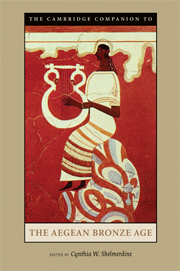Book contents
- Frontmatter
- 1 Background, Sources, and Methods
- 2 The Early Bronze Age in Greece
- 3 The Early Bronze Age in the Cyclades
- 4 Early Prepalatial Crete
- 5 Protopalatial Crete
- 6 The Material Culture of Neopalatial Crete
- 7 Minoan Culture: Religion, Burial Customs, and Administration
- 8 Minoan Crete and the Aegean Islands
- 9 Minoan Trade
- 10 Early Mycenaean Greece
- 11 Mycenaean Art and Architecture
- 12 Mycenaean States
- 13 Burial Customs and Religion
- 14 Mycenaean Greece, the Aegean and Beyond
- 15 Decline, Destruction, Aftermath
- Glossary
- Select Bibliography
- Index
- Plate section
14 - Mycenaean Greece, the Aegean and Beyond
Published online by Cambridge University Press: 28 November 2010
- Frontmatter
- 1 Background, Sources, and Methods
- 2 The Early Bronze Age in Greece
- 3 The Early Bronze Age in the Cyclades
- 4 Early Prepalatial Crete
- 5 Protopalatial Crete
- 6 The Material Culture of Neopalatial Crete
- 7 Minoan Culture: Religion, Burial Customs, and Administration
- 8 Minoan Crete and the Aegean Islands
- 9 Minoan Trade
- 10 Early Mycenaean Greece
- 11 Mycenaean Art and Architecture
- 12 Mycenaean States
- 13 Burial Customs and Religion
- 14 Mycenaean Greece, the Aegean and Beyond
- 15 Decline, Destruction, Aftermath
- Glossary
- Select Bibliography
- Index
- Plate section
Summary
Introduction
In the Late Helladic period the Mycenaeans established an extraordinary network of overseas contacts, which stretched the length of the Mediterranean and beyond. A prime motive will have been the acquisition of crucial raw materials that Greece lacked, but it is clear that there were other contributory factors, especially at the elite and palatial levels of society. A number of key questions therefore must be addressed. Was there trade and, if so, in what, for whose benefit and by whom? Were political alliances negotiated with foreign states? Did the Mycenaeans conduct military campaigns or settle overseas? What, if any, influence did they have on other societies? This chapter first looks at the evidence provided by texts from the Aegean, the Near East, and Egypt for the organization of trade at this time, and then uses the evidence of shipwrecks in particular to consider what was traded. The regions that came into contact with the Mycenaeans - the Cyclades, the Dodecanese, Macedonia, Troy and the Black Sea, Anatolia, Cyprus, Syria-Palestine, Egypt, and Italy - are each treated separately, because the evidence cannot be satisfactorily interpreted unless it is put into context. Finally, the key questions are reviewed in the Conclusions.
- Type
- Chapter
- Information
- The Cambridge Companion to the Aegean Bronze Age , pp. 362 - 386Publisher: Cambridge University PressPrint publication year: 2008
- 9
- Cited by

